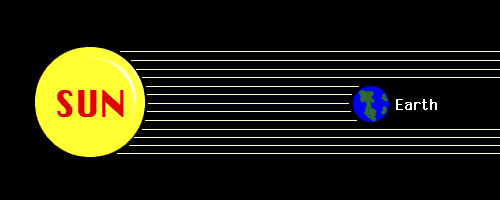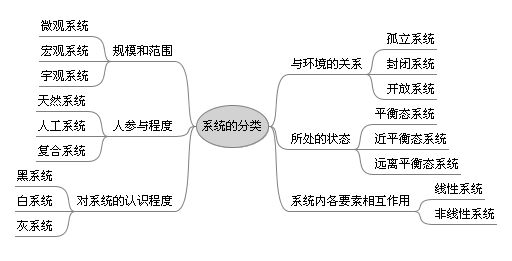系统是什么?
KEY: 科学哲学 系统 系统理论 模型
系统与模型
(a). Humans and Their Models
One common conclusion of scientific inquiry(质询; 调查 ) is that the world of nature is often very complex. To understand this complexity, scientists usually try to envisage(想像, 设想;) the phenomena of nature as simplified versions of reality known as a system. A system can be defined as a collection of interrelated parts that work together by way of some driving(精力旺盛的; 强劲的; 驱使的 ) process.
我们对自然界进行研究的一个常见的结论就是,自然界是很复杂的。为了把握这些复杂性,科学家通常把自然现象假想成一种简化过的实在(reality),它就是我们常常听到的“系统”。“系统”可以被定义成相关部分(或者叫子系统)的集合,这些子部分在某种驱束力下工作在一起。
In the world of science, the word model is quite similar in meaning to the term system. Models in science tend to be simplified representations of reality that can be explained of mathematically and through the use of graphics. The following graphical model is used to help explain the processes involved in scientific understanding. The arrows in this graphically model suggest a continuous interaction between perceptible(可察觉的, 看得见的) phenomena and theory through the processes of explanation and validation. This simple graphical model, while an extreme abstraction of the real world, is quite useful in explaining how scientific understanding works.
在科学的世界里,“模型”一词与“系统”有十分相似的意思,只是二者偏重有点不一样。模型偏向于简化实在的表征,从而有助于数学地或图形化地对实在进行解释(explained)。比如下面的图形模型,它是用来帮助解释科学认识(scientific understanding)的过程的模型。在这幅生动的模型图中,箭头有形地展示(suggest)了透过解释和验证的过程在理论(theory)与现象(phenomena)之间存在的连续不断的交互。这也是科学认识的本质过程。这幅相当抽象的构图很简单,但对于解释科学认识的原理很有用。
KEMIN:没有讲“系统”偏向简化实在的什么东西。

Figure 4a-1: The general relationship between perceptible phenomena and theory using scientific method for understanding. The interaction between perceptible phenomena and theory is arrived at through the processes of explanation and validation.
In Physical Geography, and many other fields of knowledge, systems and models are used extensively as aids in explaining natural phenomena around us.
在各知识领域里,系统和模型被广泛地用来辅助解释我们身边的各种自然现象。
系统的定义
(b). Definitions of Systems and Models
As suggested in the previous section, a system is a assemblage of interrelated parts that work together by way of some driving process (see Figure 4b-1). Systems are often visualized or modeled as component blocks that have connections drawn between them. For example, the illustration below describes the interception(拦截; 截击; 截取;) of solar radiation(太阳辐射) by the Earth. In this system, the Earth and Sun, the parts or component blocks, are represented by two colored circles of different size. The process of solar emission(发射) and the interception of the Sun's emitted radiation by the Earth (the connection) is illustrated by the drawn lines.
前面谈到,系统是一组相关部分的集合,并且这些子部分在某种驱束力下一起工作。系统常常被可视化或模型化为多个组件块,并且在这些组件块之间用线连起来表示它们的关系。比如如下的关于太阳辐射的模型图:

Figure 4b-1: Simple visual model of solar radiation being emitted from the Sun and intercepted by the Earth.
Most systems share the same common characteristics. These common characteristics include the following:
大多数系统都拥有一些通用的性质,包括如下的:
- 1. Systems have a structure that is defined by its parts and processes.
- 2. Systems are generalizations of reality.
- 3. Systems tend to function in the same way. This involves the inputs and outputs of material (energy and/or matter) that is then processed causing it to change in some way.
- 4. The various parts of a system have functional as well as structural relationships between each other.
- 系统都是有一定的结构,由组成部分和作用(processes)定义;
- 系统都是对实在(reality)的一般化(generalizations );
- 系统都有同样的表现作用的方式,作用过程包括物质和能量的输入与输出,由输入到输出,物质和能量会以某一种方式被改变或转换;
- 系统内部各部分都有功能依赖和结构制约关系;
- 5. The fact that functional relationships exist between the parts suggests the flow and transfer of some type of energy and/or matter.
- 6. Systems often exchange energy and/or matter beyond their defined boundary with the outside environment, and other systems, through various input and output processes.
- 7. Functional relationships can only occur because of the presence of a driving force(驱动力,张力).
- 8. The parts that make up a system show some degree of integration - in other words the parts work well together.
- 系统内两部分间有功能关系意味着它们之间存在着某种能量和物质的流动和传输;
- 系统通常会与定义它的边界以外的环境(包括其它系统)进行能量或物质交换;
- 功能关系只源于某种驱动力或张力的存在;
- 系统内的各部分表现出一定的集成程度,并且系统整体大于部分之和。
KEMIN:最后一点原文不好理解;还有这里能量和物质还没有进一步解开。
Within the boundary of a system we can find three kinds of properties:
Elements - are the kinds of parts (things or substances) that make up a system. These parts may be atoms or molecules(分子; 些微), or larger bodies of matter like sand grains, rain drops, plants, animals, etc.
Attributes - are characteristics of the elements that may be perceived(察觉; 意识到; 感知; 理解) and measured. For example: quantity, size, color, volume, temperature, and mass.
Relationships - are the associations that occur between elements and attributes. These associations are based on cause and effect.
在系统的边界内我们可找到三类属性:
元素(Elements):组成系统的各种部分(东西或事物)。这些系统部分可能是原子性,也可能是非原子性,比如子系统;
属性(Attributes):指被丈量或感知的系统元素的特性(characteristics);比如数量、大小、颜色、容量、温度和规模;
关系(Relationships):指在元素和属性之间存在的某种结合(associations),这些结合是基于因果关系的。
We can define the state of the system by determining the value of its properties (the elements, attributes, and/or relationships).
我们可以根据这三类属性的值(value)来定义或描述一个系统(的状况)。
系统的分类
Scientists have examined and classified many types of systems. Some of the classified types include:
Isolated System - a system that has no interactions beyond its boundary layer. Many controlled laboratory experiments are this type of system.
Closed System - is a system that transfers energy, but not matter, across its boundary to the surrounding environment . Our planet is often viewed as a closed system.
. Our planet is often viewed as a closed system.
Open System - is a system that transfers both matter and energy can cross its boundary to the surrounding environment. Most ecosystems生态系统 are example of open systems.
Morphological(形态学的; 形态的) System - this is a system where we understand the relationships between elements and their attributes in a vague sense based only on measured features or correlations. In other words, we understand the form or morphology a system has based on the connections between its elements. We do not understand exactly how the processes work to transfer energy and/or matter through the connections between the elements.
Cascading System - this is a system where we are primarily interested in the flow of energy and/or matter from one element to another and understand the processes that cause this movement. In a cascading system, we do not fully understand quantitative relationships that exist between elements related to the transfer of energy and/or matter.
Process-Response System - this is a system that integrates the characteristics of both morphological and cascading systems. In a process-response system, we can model the processes involved in the movement, storage, and transformation of energy and/or matter between system elements and we fully understand how the form of the system in terms of measured features and correlations.
Control System - a system that can be intelligently manipulated by the action of humans.
Ecosystem - is a system that models relationships and interactions between the various biotic and abiotic components making up a community or organisms and their surroundng physical environment.
能量与环境
An environmental system can be defined as a system where life interacts with abiotic factors. All environmental systems involve the capture, movement, storage, and use of energy. This fact also makes them energy systems. Energy is captured in the living components of environmental systems by processes like photosynthesis, biomass consumption, and biotic decomposition. Energy is also used in environmental processes that are strictly abiotic. For example, solar energy is responsible for wind, weathering, and precipitation.
平衡与反馈
Equilibrium can be defined as the average state of a system as measured through one of its attributes or elements. Scientists have defined six different types of equilibrium. Most systems maintain a steady state equilibrium through the operation of positive and negative feedback mechanisms. Negative-feedback mechanisms control the state of the system by dampening or reducing the size of the system's elements or attributes. Positive-feedback mechanisms feed or increase the size of one or more of the system's elements or attributes over time. This section concludes by showing how negative and positive feedbacks work to cause fluctuations in the population size of aphids.
分享到:








 . Our planet is often viewed as a closed system.
. Our planet is often viewed as a closed system.


相关推荐
2. OA办公系统的主要功能是什么? OA办公系统的主要功能包括文件管理、共享下载、通知管理、新闻管理、工作日志、人力资源、通讯录、电子邮件等。 3. 系统的架构设计是什么? 系统采用B/S架构设计,即浏览器/服务器...
1.如何调节系统音量?(Visual C++编程 源代码)1.如何调节系统音量?(Visual C++编程 源代码)1.如何调节系统音量?(Visual C++编程 源代码)1.如何调节系统音量?(Visual C++编程 源代码)1.如何调节系统音量?...
微盘交易系统是什么?微盘交易系统就是一款基于微信程序的微型现货交易平台,该平台将移动互联思维与金融产品结合在一起,依托于微信公众号,无需额外下载手机应用程序,扫描二维码、关注即可实时注册并与国际...
ERP系统与MES系统如何对接?
提到ERP选型,难免不会提到金蝶,金蝶ERP怎么样?金蝶ERP的优缺点?金蝶ERP用户口碑怎么样? 想了解这些信息,您应该到选型宝,B2B的大众点评,看看用户对金蝶ERP产品的实名点评。 关于金蝶ERP, 以下信息来自选型宝...
食品管理系统是一个涵盖食品行业库存、销售、采购等关键业务流程的综合信息管理系统。在这个系统中,C语言可能被用于编写底层的数据处理和系统核心逻辑,因为C语言具有高效、低级特性和良好的移植性,适合处理对性能...
什么是系统还原点? 系统还原点是指可以保存系统当前状态的快照,以便在系统出现故障时快速恢复系统到之前的状态。系统还原点可以保存系统的所有设置和软件状态等,包括安装的应用程序、驱动程序、系统配置等。 为...
国产操作系统大全 国产操作系统有哪些?这是一个许多人想知道的问题,尤其是在微软停止对 Windows XP 的服务之后。那么,国产操作系统有哪些呢?下面我们来了解一下国产操作系统的种类。 首先,我们有思普操作系统...
什么是楼宇自控系统?
我们在学习STM32到一定阶段可能会了解操作系统,然后便有这种问题产生,下面我就来粗略说说“操作系统与裸机的区别,以及STM32能运行什么操作系统,能运行linux系统吗”等问题。 操作系统与裸机的区别 裸机运行的...
什么时候需要?”等几个问题。它是一个时段优先计划系统,其主要对象是决定制造与采购的净需求计划。它是由主生产计划推动运行的,但反过来,它又是主生产计划的具体化和实现主生产计划的保证计划。 由于物料...
电网调度自动化系统是电力系统运行和管理的重要组成部分,它通过先进的信息技术和通信技术,实现对电网运行状态的实时监测、控制和管理,从而确保电网的安全、稳定和经济运行。电网调度自动化系统的基本结构通常包括...
西门子雷电对SITRANS FUS1010系统有什么影响?pdf,西门子雷电对SITRANS FUS1010系统有什么影响?雷电对SITRANS FUS1010系统有什么影响?解答:在很多案例中,直到第二次发生,客户也不会想到雷电是造成损坏的原因。
什么是嵌入式系统?其特点有些什么? 嵌入式系统的BooTLoader的功能是什么? 目前嵌入式操作系统有哪些? 构造嵌入式开发环境有哪几种形式? 嵌入式系统开发的基本流程? 什么是可编程片上系统? 有时要使用Thumb技术...
* 下面哪种操作系统不属于商用操作系统? * 如下命令可以知道 shell 命令的用法是什么? * 关于 NAND FLASH 与 NOR FLASH 的区别,正确的是什么? * 可以用什么命令查看 linux 使用了多少内存? * 一般可以用什么...
这种强大的能力使得GPT在各种自然语言处理任务上都有广泛的应用,例如文本生成、问答系统、机器翻译、对话系统、代码生成等。 对于用户来说,GPT可以帮助你完成以下任务: 1. **文本生成**:无论是文章、故事还是...
1.VB是什么? VB是visual Basic的简称,即初学者通用符号代码,是很容易入门的语言,从BASIC发展而来。 2.学VB有什么用? VB是一门编程语言,所以能用VB做的很多很多,基本上除了底层开发(系统软件),VB都能做,...
fg793p.exe尹鸿软件,固态硬盘的win10系统如何上网?fg793p.exe尹鸿软件,固态硬盘的win10系统如何上网?
* 采用建议系统可能带来的影响:仓库管理系统的开发可能会对仓库管理带来什么影响? * 技术可行性评价:仓库管理系统的技术可行性如何? 5. 信用经济可行性分析 信用经济可行性分析是指对仓库管理系统的经济可行性...
1. 缓冲罐的定义和作用:解释什么是缓冲罐,它在管道系统中的功能,以及为什么需要这种设备来稳定压力。 2. 缓冲罐的类型:介绍不同类型的缓冲罐,如金属罐、混凝土罐、塑料罐等,及其适用场景。 3. 设计标准与...